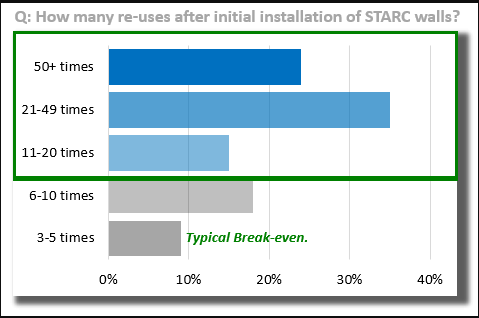
STARC’s impact to date? Over 160,000 yd3 of single-use drywall waste saved… and counting
Updated October 17, 2024
In today's construction industry, sustainability is paramount. Traditional methods—characterized by high waste, significant carbon emissions, and excessive resource consumption—pose considerable environmental challenges. In response, architecture, engineering, and construction (AEC) firms are increasingly embracing innovative, eco-friendly practices. At the forefront of this transformative shift are temporary wall systems.
Transforming Construction: Temporary Walls
The increasing adoption of reusable temporary construction walls for the containment of construction waste and debris underscores an important promise to reshape the industry's sustainability landscape.
- Less waste, more savings: Traditional construction often results in a high percentage of wasted materials. Prefabrication, on the other hand, minimizes waste through precise design and manufacturing processes. Each component is carefully designed for a perfect fit, drastically reducing waste production. In addition, the high reusability of temporary wall systems allows for extended use over multiple projects, further driving down waste and saving costs.
- Efficient and sustainable transportation: Moving away from the typical scenario of hauling countless raw materials and tools to a construction site, delivering a finished wall changes everything. This shift towards transporting completed components significantly reduces the energy footprint, leading to lower carbon emissions, more sustainable logistics, and a greener supply chain.
- Containing work areas is key: Prefabricated temporary construction walls act as a robust barrier against the spread of noise, dust, and debris during renovations. Effectively containing these elements minimizes disruption and resource use in clean-up efforts. The outcome is not just a more pleasant and productive environment; there’s an operational efficiency that aligns perfectly with sustainability.
Durability and Reusability Unlock Green Potential
One company that has interwoven green practices into its core operations—with remarkable outcomes—is STARC Systems. The superior design and durability of STARC's reusable temporary walls ensure a long product life cycle.
According to the findings of a recent survey, nearly half of STARC’s customers have reused their original purchases 20 or more times. Seventy-four percent report using STARC panels 11 or more times.

STARC’s Green Impact to Date: Over 160,000 yd3 waste saved… and counting! 100 linear feet of STARC walls re-used five times saves 9.3 cubic yards and 5 tons of landfill waste(1).
In addition, STARC is demonstrating leadership as a:
- Waste warrior: STARC’s commitment to reducing waste is genuinely commendable. The company has prevented 160,298 cubic yards of single-use drywall from going to landfills1 by producing the most durable temporary containment systems on the market. That’s roughly 90,546 TONS of drywall—the equivalent of 45,273 Ford F-150s!3
- Carbon footprint reducer: STARC has made impressive strides in reducing emissions, bypassing the carbon-intensive process required to produce drywall with far more environmentally friendly temporary containment systems. To date, STARC has avoided producing over 35,000 tons of CO2 emissions in gypsum production for temporary containment.2
- Efficiency exemplar: The efficiency with which STARC's products are managed is exemplary. The company notes that 95% of contractors return walls to central storage or immediately reinstall them. This level of efficient resource management minimizes waste and sets a compelling model for others in the industry to follow.
A Sustainable Future With Temporary Construction Walls
In this sustainability-focused era, STARC’s temporary wall systems present a solution that marries environmental responsibility with versatility, safety, cost-effectiveness, and operational efficiency.
As the construction industry navigates its transition to sustainability, STARC is doing its part, offering solutions that are not just sustainable but also pave the way for a better future. To learn how STARC can help you achieve your sustainability goals, contact us today.
Sources and methods.
(1) Linear feet and landfill impacts calculated from 2022 customer re-use survey and customer purchase history.
(2) EPA conversion factors applied to tonnage of drywall waste avoidance estimates.
(3) Average weight of an Ford F-150 is approximately 4,000 pounds, depending on the model and trim.
Interested in More Information on STARC Systems?
